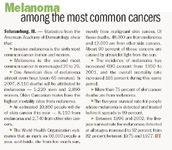- Case-Based Roundtable
- General Dermatology
- Eczema
- Chronic Hand Eczema
- Alopecia
- Aesthetics
- Vitiligo
- COVID-19
- Actinic Keratosis
- Precision Medicine and Biologics
- Rare Disease
- Wound Care
- Rosacea
- Psoriasis
- Psoriatic Arthritis
- Atopic Dermatitis
- Melasma
- NP and PA
- Skin Cancer
- Hidradenitis Suppurativa
- Drug Watch
- Pigmentary Disorders
- Acne
- Pediatric Dermatology
- Practice Management
- Prurigo Nodularis
- Buy-and-Bill
Article
Refocusing public awareness
The AAD says melanoma incidence is increasing at an alarming rate, and its statistics indicate that science has a long way to go to find reliable treatments. Meanwhile, some dermatologists think the primary focus of public awareness campaigns should be on early detection in addition to just sun safety.

Key Points

And one school of thought holds that efforts to educate the public about prevention are focused on the wrong message.
"We should be focused more on identifying people who are at high risk rather than urging people to stay out of the sun," says Arthur R. Rhodes, M.D., director of the Melanoma Surveillance Center and professor of dermatology at Chicago's Rush University Medical Center.
According to the AAD, the overall incidence of melanoma is rising at an alarming rate.
Between 1950 and 2001, academy statistics show, the incidence rose 690 percent, and the overall mortality rate increased 165 percent.
The AAD's 2007 statistics on skin cancer in general and melanoma in particular reveal that:
Focusing the message
For years, the AAD, the American Cancer Society and other organizations have carried on public awareness campaigns urging people to take steps to protect themselves from the sun's ultraviolet rays, which the AAD says is the most preventable cause of melanoma.

In a 2006 article he authored and which appeared in the journal Dermatologic Therapy, Dr. Rhodes writes, "Establishing an early diagnosis in a pre-metastatic phase of tumor development must be the overriding goal of any intervention strategy that seeks to reduce cutaneous melanoma (CM)-related mortality.
"Unfortunately, as a result of public messages that emphasize the role of ultraviolet radiation exposure in tumor development, most general physicians and lay people believe that most, if not all, cases of CM are the direct result of UVR exposure.
"In fact, we do not know the case fraction of CM directly attributable to UVR, and the unintended consequences of current messages directly linking UVR exposure and CM development may be thwarting the primary intervention goal of reducing tumor-related mortality."
More likely to have an immediate positive impact on melanoma mortality, he says, are public messages that encourage skin awareness and self-examination by patients, skin screening examinations by physicians during routine care, and periodic lifetime surveillance of patients determined to have a high melanoma risk based on identifiable historic and phenotypic traits.
Dermatologist Darrell Rigel, M.D., agrees.
"The most important factor in slowing down the incidence of melanoma is early detection," says Dr. Rigel, clinical professor of dermatology at the NYU Medical Center, New York.





